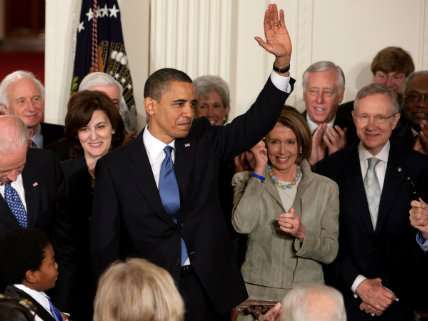Ignore the Administration's Inflated Obamacare Coverage Numbers

In a speech to the Democratic Governor's Association last week, president Obama touted the success of Obamacare's Medicaid expansion. "We've got close to 7 million Americans who have access to health care for the first time because of Medicaid expansion," he said.
That's false.
We don't know how exactly many people have gotten health coverage through Medicaid for the first time as a result of Obamacare, but the actual number is certainly much lower than the 7 million President Obama claimed.
As The Washington Post's Fact Checker explains—again—the 7 million figure comes from reports counting the number of people who have enrolled in Medicaid since October 1 last year, when Obamacare's online exchanges launched. But many of those enrollments are in states that did not participate in the law's Medicaid expansion, and many of those who signed up in states that did participate were renewing existing coverage. Avalere Health, a health consulting firm that has been tracking Obamacare's implementation, estimates that the number of new enrollees is somewhere in the range of 1.1 to 1.8 million. (And that number counts people who were previously eligible prior to Obamacare's Medicaid expansion but signed up after the fact.)
That's Medicaid. What about private coverage? Once again, solid numbers are hard to pin down. But the true number of enrollees is virtually certain to be lower than the administration's headline estimates.
The administration said earlier this month that, by the end of January, 3.3 million people had signed up for private coverage through the exchanges. But that figure leaves two important questions unanswered: How many people have paid the first premium, a requirement to actually be enrolled in coverage? And how many of those people were previously uninsured?
We don't have good answers to either question. But we can be pretty sure that once we do, the total will be substantially lower than the administration's topline number.
Several reports have cited insurance industry insiders to estimate that roughly 20 percent, and perhaps as much as 30 percent, of exchange-based coverage sign-ups haven't paid.
That means a significant downward revision is coming—a 20 to 30 percent reduction would bring total enrollments down to between 2.31 million and 2.64 million.
But remember: Millions of people had their individual insurance policies cancelled as a result of Obamacare. Some policies that were set to be cancelled under the law were extended for a year, but even still, it's likely that there's a sizable cohort of individuals who lost coverage and moved into exchange-based policies. Other previously covered people may have moved into the exchanges for different reasons.
What that means is that the number of previously uninsured people who have gotten covered through the exchanges is probably even lower than the number of paid enrollments. How much lower? We really don't know. At some point, this information may be tracked by the administration through the exchanges. But not for a while. That functionality is among many crucial website back-end features that have not been completed yet.
Basically, reliable numbers are impossible to come by at this point. And as this Politico report notes, we may not know for a lot longer. Without real-time tracking through the exchanges, we'll have to wait for a reliable independent study—or census data when it comes out next year. Until then, inflated claims of success like the one President Obama made last week ought to be ignored.


Show Comments (33)